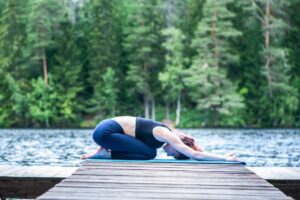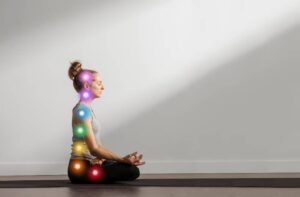The Yoga Blogs
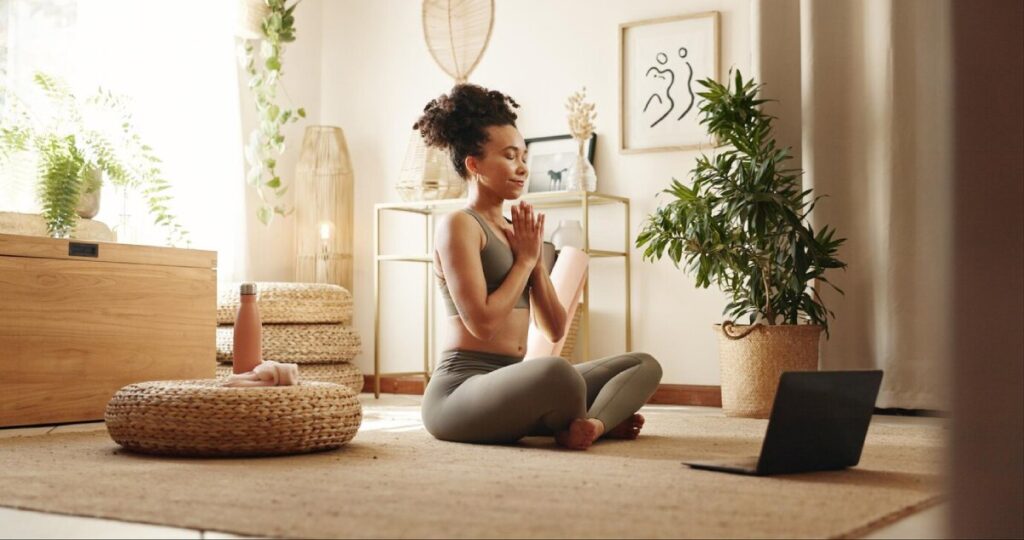
Designing a Home Yoga Space for Focus and Peace
Imagine this: you roll out your yoga mat. Soft light filters through the window, and the air carries a hint of lavender. Your mind quiets effortlessly. Blissful, right?
In our busy world, having a dedicated home yoga space is essential. It helps foster mental clarity, emotional balance, and lasting inner peace. A well-designed space makes it easier to focus on your practice and connect with yourself.
No matter if you’re an expert yogi or a beginner, making your home mindful can transform both your practice and your life.
In this guide, we’ll cover everything you need to design your ideal home yoga space. This space will boost your focus and create a deeply peaceful environment. Expect practical ideas, emotional insights, and inspiring examples to ignite your creativity.
Let’s dive in.
Why Your Environment Matters in Yoga Practice
Your Space Reflects Your Inner World
Yoga unites body, mind, and breath. But practising in a cluttered environment can make it hard to concentrate. Your senses stay agitated, and your mind resists settling.
A peaceful environment supports:
- Sensory withdrawal (pratyahara)
- Single-pointed focus (dharana)
- Deeper meditation (dhyana)
As the saying goes, “Outer order contributes to inner calm.”
Science Backs It Too
Research shows that tidy, calm spaces can cut stress, lower cortisol, and boost brain function. Your surroundings literally affect your ability to think clearly and feel calm.
A dedicated yoga space trains your brain: “Here, I slow down. Here, I breathe deeply. Here, I reconnect.”
Key Elements of a Home Yoga Space
You don’t need a large studio. You just need intention, simplicity, and consistency.
Here are the essential elements to consider:
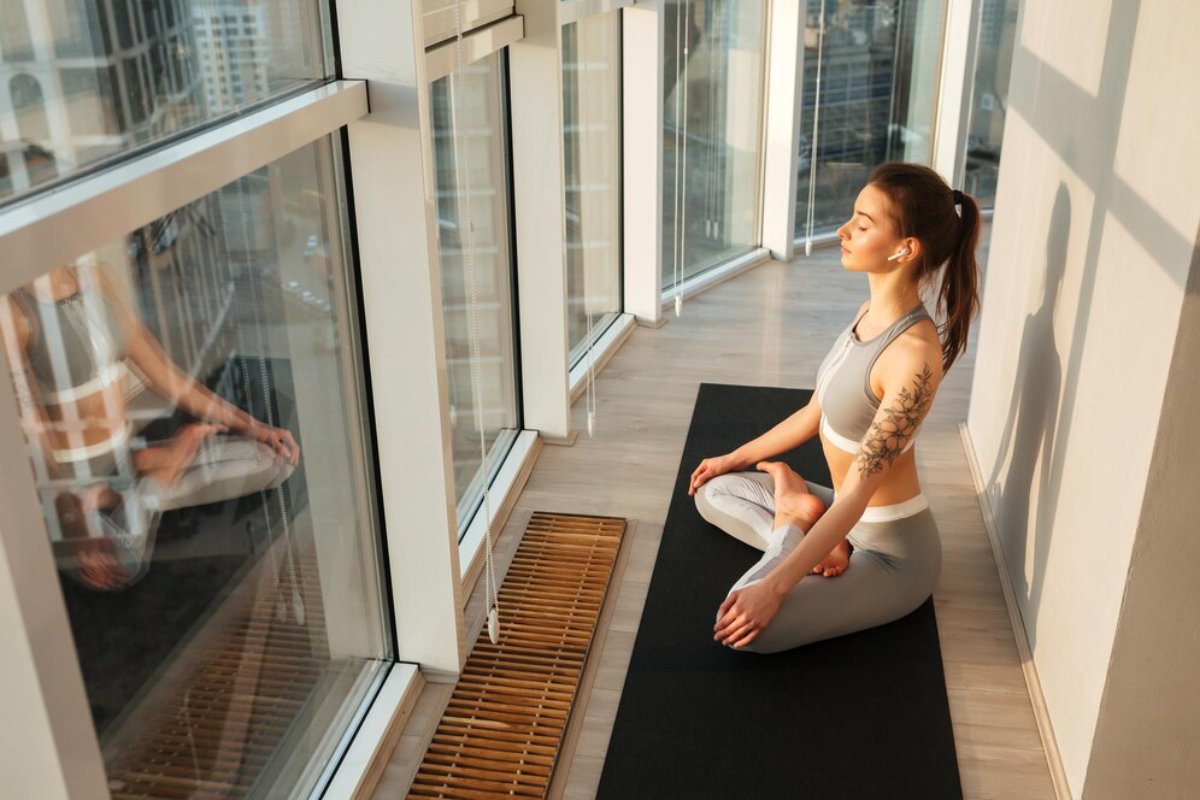
1. Choose the Right Spot
Select a space that feels safe, inviting, and somewhat private.
Ideal characteristics:
- Quiet or semi-quiet area
- Good natural light (optional but uplifting)
- Enough room to stretch and lie flat
- Ventilation for fresh air
Pro tip: Even a corner of your living room, a section of your bedroom, or a spot on your balcony can work beautifully if approached mindfully.
2. Declutter and Simplify
Clutter bombards the senses and distracts the mind. Clear away:
- Unnecessary furniture
- Visual distractions (laundry, paperwork)
- Non-essential electronics
Minimalism = mental spaciousness.
Ask yourself: “Does this object help me focus or pull me away?” If it pulls you away, it’s time to go.
3. Ground Your Space with a Quality Mat
Your yoga mat is your sanctuary — your anchor to the earth.
Look for:
- A mat with good grip and cushioning
- Colours that evoke calm (soft greens, earthy tones, gentle blues)
You can layer it with a cotton rug for extra texture and warmth.
4. Incorporate Natural Elements
Nature soothes. Including natural materials connects you to the earth.
Ideas to weave nature into your space:
- Houseplants (peace lilies, ferns, snake plants)
- Wooden props or accessories
- Stones, shells, or crystals
- A small water feature or sound of running water
Even a simple vase of fresh flowers can shift the energy.
5. Mindful Lighting
Lighting sets the emotional tone of a space.
For yoga focused on mental clarity, use:
- Natural daylight when possible
- Soft, warm lamps for mornings or evenings
- Candles during meditation or restorative sessions
Avoid harsh overhead lighting that overstimulates.
6. Create a Sensory Experience
Engaging the senses can deepen focus.
Consider:
- Smell: Essential oils (lavender, sandalwood, eucalyptus) or natural incense
- Sound: Soft instrumental music, nature sounds, or silence
- Touch: Soft blankets, natural-fibre props
- Sight: Inspirational art, vision boards, or serene imagery
Keep sensory inputs subtle — they should enhance stillness, not distract.
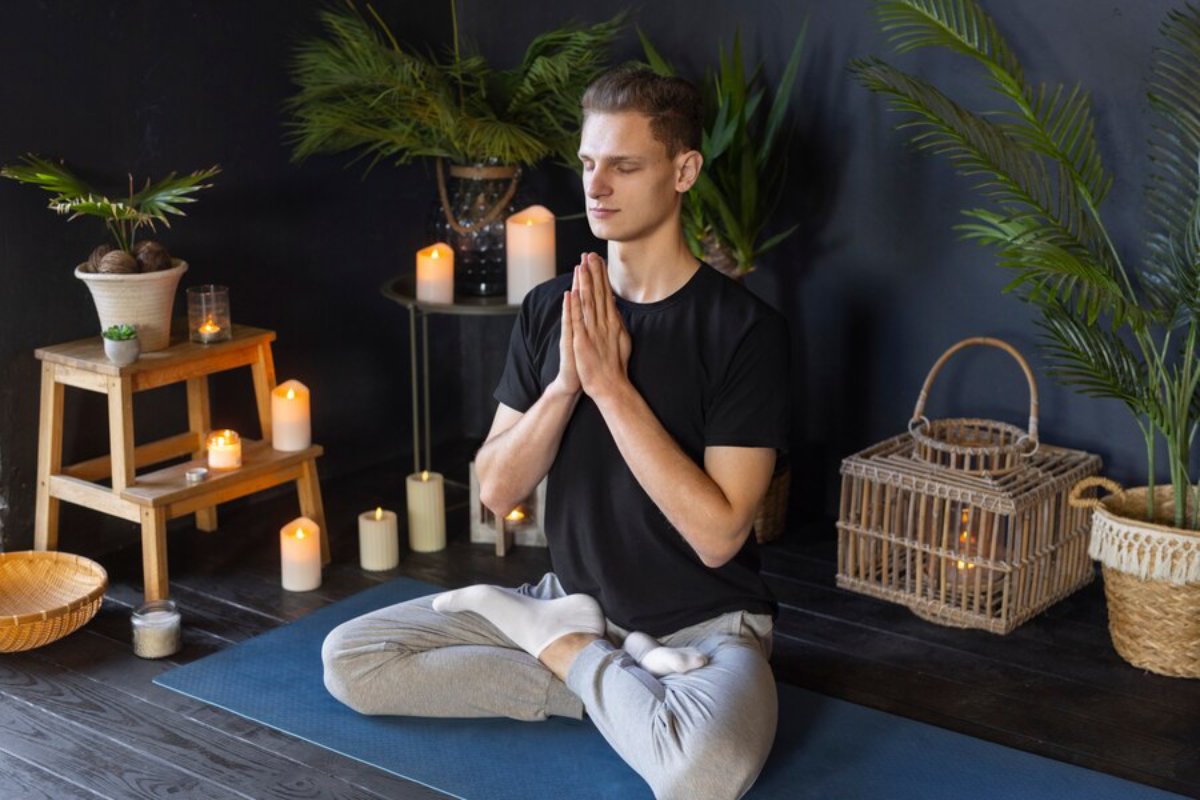
7. Anchor with a Sacred Touch
Adding a small focal point gives your space meaning.
This could be:
- A small altar with a candle, crystal, or meaningful object
- A photo, quote, or mantra that inspires you
- A meditation cushion that feels inviting
When you sit by your “anchor,” it cues you to slow down and turn inward.
Designing for Focus: Practical Layout Tips
Space Planning Made Simple
- Place your mat parallel to a window or facing a blank wall.
- Leave a few inches around your mat for movement.
- Store props (blocks, straps, bolsters) within easy reach but neatly.
- Avoid facing clutter, busy décor, or screens.
Think open, grounded, breathable.
Inspiring Examples:
- Tiny Corner Sanctuary: A mat, one plant, a soft blanket, and a candle.
- Balcony Zen Nook: Bamboo mat, fairy lights, low stool for seated practice.
- Multi-use Calm Zone: Use a folding screen or low bookcase to section off a part of your living room for yoga.
It’s about feeling right — not looking perfect.
Making It a True Yoga Lifestyle
Daily Rituals to Anchor Your Practice
- Morning: Open your space (light a candle, open curtains, play soft music).
- Pre–Practice: Sit quietly for one minute, set an intention.
- Post–Practice: Tidy your space, express gratitude, and close it consciously.
Consistency tells your nervous system: This is a safe, sacred place to reset.
Blending Space and Mind
Remember, designing your space and your mind are parallel processes.
- Decluttering the room? Declutter your thoughts.
- Adding plants? Nourish your body too.
- Creating beauty? Affirm your own inner beauty and worth.
Your space becomes a mirror for your inner journey.
Real-Life Story: How a Tiny Space Transformed My Practice
When I started yoga at home, I practised in a cluttered corner. My mat was squeezed between a desk, a clothes rack, and old books. My mind mirrored the mess: distracted and restless.
One weekend, I cleared a tiny space by the window. I added a plant, a small candle, and neatly folded clothes.
The difference was stunning. My practice deepened. I stayed longer in postures. I meditated with ease. I craved my mat because it felt good.
Lesson learned? Space shapes spirit.
Common Mistakes to Avoid
Even with good intentions, it’s easy to fall into traps:
- Overcomplicating the design: You don’t need a Pinterest-perfect setup.
- Letting clutter creep back in: Maintain your space with small daily resets.
- Forgetting personalisation: Your space should reflect you, not someone else’s Instagram feed.
- Ignoring comfort: If a posture feels hard because the mat is slippery or the light is harsh, you’re less likely to show up consistently.
Simple, honest, and loving beats flashy every time.
Your Home, Your Haven
Your home yoga space is more than just a physical area. It’s a commitment to your wellbeing, clarity, and inner calm. It’s a daily reminder that you deserve time, attention, and sanctuary.
Creating a calm space helps you focus. This supports a more centred version of yourself, not only in yoga but in every part of life.
Ready to start? Clear one small space today. Lay down your mat. Breathe. Let it be simple. Let it be yours. Which element will you add to your yoga space first? Share your thoughts in the comments. Pass this on to anyone building their sanctuary. Also, subscribe for more heartfelt tips!
Because peace doesn’t just happen — it’s something you design into your daily life.




